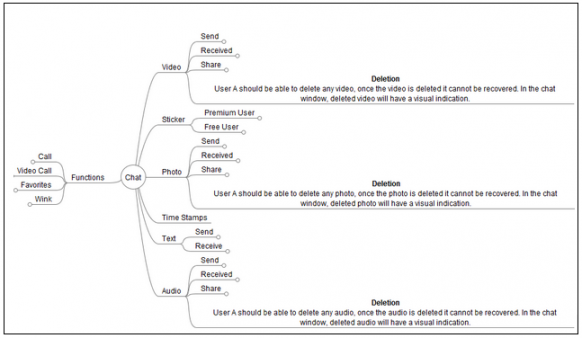If you have to explain the flow of an application to your QA team keeping in mind the test cases and their respective attributes, how would you go about it? Would you prepare a long-winded presentation with a lot of big words which may make you sound like an expert but which won't help your team grasp the concept?
 Or would you present your concept graphically with mind mapping software so that it does most of the explaining for you and leaves a lasting impression on your team?
Or would you present your concept graphically with mind mapping software so that it does most of the explaining for you and leaves a lasting impression on your team?
For instance, if you have to test the chat feature of a mobile application and its attributes, mind maps are an easy way to represent the test cases visually. This facilitates your task as a QA team leader since your team can understand the application flow rapidly and without a lengthy explanation. The result is a QA process executed in a clearer and more thorough manner.
Mind Maps Are Useful For QA
The field of software quality assurance can benefit greatly from the use of mind maps as they aid in the presentation of ideas in a visual manner. Mind maps help in brainstorming, in the processing and analysis of ideas, and in the presentation of the concept to the team in a lucid manner. It is a powerful and creative visual tool which ensures a better understanding of concepts.
For the creation of a mind map in relation to QA purposes, the creator has to pay careful attention to each test case and its attributes - regardless whether performing manual testing or automated testing, the flow of the application has to be kept clearly in mind so that both the precise details and the high-level overview are accurate. This frequent zooming in and out of focus is a common cause of errors and omissions.

This is a mind map showing the attributes of the Chat function of a messenger app and the test cases which can be developed from them.
The common misconception about mind maps is that they are complicated to create. A person who is new to the concept may find themselves completely lost regarding the making of a mind map, and once they start, they will be surprised at how easily it can be accomplished.
Mind maps are easy to make: all you need is knowledge about the topic and clarity of thought. They represent the concept in the form of a map which shows how it has been visualized by the product owner. To create mind maps, various symbols, shapes, colors and lines are used so that information is displayed in an effective and structured way. This makes it easier to analyze and plan any future action.
How To Make Mind Maps
- Start with the main topic in the center. As shown above, ‘Chat’ is the starting point of our mind map.
- The main attributes of your primary topic are shown branching out from this central idea and are referred to as ‘child nodes’. In our example, we have ‘Video’, ‘Sticker’, ‘Photo’, ‘Time stamps’, ‘Text’, and ‘Audio’.
- Each of these main branches can be further broken down, ultimately into individual test cases.
- These nodes can be color coded and can also be marked with images to highlight their priority.
- The nodes are expandable or collapsible depending on the user requirements.
- The text used in mind maps should be concise so that the visual element makes a better impact.
Why Use Mind Mapping Software?
Whether using mind maps as a software testing service or as an individual contributor, there are many applications available in the market to help you display your content in a presentable and prompt way. Solutions like Xmind, Freemind and MindMeister all provide many functions and shortcuts which are effective in the creation of mind maps for software testing.
Here is why using mind maps is a good idea:
- It helps in better understanding of the concept as a visual representation of ideas always creates a clearer and more long lasting image in the user’s mind.
- The tools available in the software help to highlight the important nodes in color or by using images. So the mind map is visually appealing and generates interest in the topic.
- They help the Quality Assurance team in effectively projecting the effort involved in the testing of the application for the client.
- As a company providing software testing services, mind maps make it easy for the concepts to be revised and recalled and are thus, an effective feedback mechanism from client to service provider.
- They make it easy for the QA team to identify use cases which are subsequently used as the foundation for test cases. If desired, the test cases and even results can recorded on the map as they are executed.
But, it should be noted that test results and reporting are probably best handled by a dedicated software testing tool which can has built-in functionality to easily display metrics for the team and stakeholders alike.
With their inherent benefits, mind maps are an ideal addition to a QA engineer’s list of software testing tools. They have the potential to fill in the void between visualization of the use cases and the execution of test cases, thus making the process of quality assurance easier and more comprehensive.
Tools for mind mapping
Freemind
 Freemind is a free mind mapping application which allows the user to generate a hierarchy of ideas around the central topic. The mind map can be expanded as new ideas take shape. It is a Java application and can be used across platforms. (www.freemind.com)
Freemind is a free mind mapping application which allows the user to generate a hierarchy of ideas around the central topic. The mind map can be expanded as new ideas take shape. It is a Java application and can be used across platforms. (www.freemind.com)
Xmind
 Xmind is another open source mind mapping application which helps to develop ideas with clarity and precision so that the management of the information can be facilitated and the team can work better for greater productivity. (www.xmind.com)
Xmind is another open source mind mapping application which helps to develop ideas with clarity and precision so that the management of the information can be facilitated and the team can work better for greater productivity. (www.xmind.com)
Mindmeister
 Mindmeister is a mind mapping software which allows users to work in the cloud so that they can collaborate in real-time, manage their tasks and create presentations. Mind maps can be shared with any number of users via the cloud. (www.mindmeister.com)
Mindmeister is a mind mapping software which allows users to work in the cloud so that they can collaborate in real-time, manage their tasks and create presentations. Mind maps can be shared with any number of users via the cloud. (www.mindmeister.com)
With better mind-mapping, you can frame your ideas in a constructive, connected way. But, how do you come up with those ideas in the first place? Well, here are our tips for innovative testing solutions.

